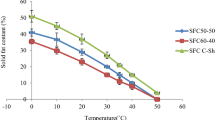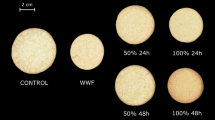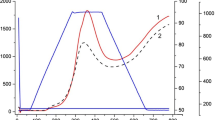Conclusions
1. Neither the peroxide value nor active oxygen hour rating are indicative for quality of frying shortenings used in preparing doughnuts.
2. Fat absorption is not a function of the degree of saturation of frying shortenings.
3. Fat absorption is not a function of the free fatty acid below 0.6%.
4. Added fatty acids decrease the pre-quality period of frying shortenings.
5. The active oxygen hour rating of a frying shortening before and during frying is not indicative of incipient rancidity in absorbed doughnut shortening.
Similar content being viewed by others
References
King, Roschen and Irwin. Oil and Soap9, 89 (1932).
Lowe, B. Research Bulletin 279, Iowa State College.
Thiessen, E. J. Food Research4, 135–143 (1939).
Lea, C. H. Rancidity in Edible Fat. The Chemical Publishing Co., Inc., New York (1939).
Hilditch, T. P. Chemical Constitution of Natural Fats, London, Chapman and Hall, Ltd. (1940).
Author information
Authors and Affiliations
About this article
Cite this article
Arenson, S.W., Heyl, E.G. A comparative study of the influence of various liquid and solid vegetable shortenings upon doughnut physical characteristics. Oil Soap 20, 149–151 (1943). https://doi.org/10.1007/BF02640155
Issue Date:
DOI: https://doi.org/10.1007/BF02640155




